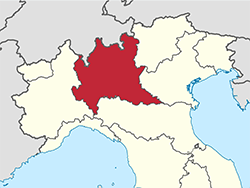Lombardy is the region in northern Italy just south of the Swiss cantons of Ticino and Graubünden. Its capital Milan is only about 50 km from the Swiss border. It is the most populous region in Italy and the country's leading economic power.
Milan is not only Italy's largest city after Rome, but also one of the world's fashion capitals and the country's largest urban area, with over 8 million inhabitants.
Lombardy is also the region of the great lakes of northern Italy, from Lake Maggiore shared with Piedmont and Switzerland in the west to Lake Garda shared with Veneto and Trentino-Alto Adige in the east, via the Ceresio (or Lake Lugano) shared with Switzerland, Lake Como and Lake Iseo.
The south of Lombardy extends over the Po plain, a long river that rises in the west, in Piedmont, and flows into the Adriatic Sea in the east, in Veneto.
All of northern Lombardy is mountainous, with a high point of 4020m at Punta Perrucchetti, a peak in the Bernina range in the Rhaetian Alps, a massif that straddles Italy and the Swiss canton of Graubünden.
The Valtelline, a large valley in north-eastern Lombardy, shares part of its history with Switzerland. While it had belonged to the Duchy of Milan since the 14th century, in 1512 it came under the control of the Three Graubünden Leagues, which were allied to the Confederation of the XIII Cantons.
After years of disputes and wars, in 1815 it became part of the Austrian-ruled Kingdom of Lombardy-Venetia. In 1859, Lombardy became part of the Kingdom of Sardinia and in 1861 of the Kingdom of Italy, the basis of modern Italy.
 |
The Pictorial Guides
© fusions.ch 1988-2025
All rights reserved for all countries |

|






